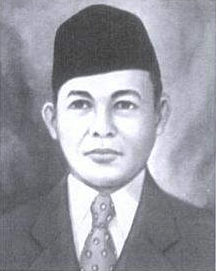Mohammad Husni Thamrin
| Mohammad Husni Thamrin | |
|---|---|
 Portrait of Mohammad Husni Thamrin | |
| Born |
16 February 1894 Weltevreden, Batavia, Dutch East Indies |
| Died |
11 January 1941 (aged 46) Senen, Batavia, Dutch East Indies |
Resting place | Karet Bivak Cemetery, Jakarta |
| Nationality | Indonesian |
| Occupation | Politician |
| Years active | 1919–1940 |
| Awards | National Hero of Indonesia |
Mohammad Husni Thamrin (16 February 1894 – 11 January 1941) was an Indonesian political thinker and National Hero.
Biography
Thamrin was born in Weltevreden, Batavia (modern day Jakarta), Dutch East Indies, on 16 February 1894.[1] His father, Tabri Thamrin, was a district head (wedana) under Governor General Johan Cornelis van der Wijck. After graduating from Koning Willem III Gymnasium,[1] Thamrin took several government jobs before working for the shipping company Koninklijke Paketvaart-Maatschappij.[2]
In 1919, Thamrin was elected a member of the Jakarta City Council. He later became deputy mayor. In 1927 he was elected to the Volksraad; he soon formed the National Fraction (Fraksi Nasional) to unite ten groups of Indonesian nationalists under one flag[2] and counteract the reactionary Fatherlands Club (Vaderlandsche Club). Along with Dr. Soetomo, Parindra's chair, Thamrin believed that independence could be achieved through cooperation with the Dutch colonial government.[3]
As a Volksraad member, Thamrin and Kusumom Utoyo went to eastern Sumatra to look into working conditions at plantations there. Disgusted by what they found, upon his return Thamrin gave a speech condemning the plantation owners.[2] He criticised the legalised gambling and corporal punishments given for minor offences.[4] In 1935 he was a founding member of the Grand Indonesia Party (Partai Indonesia Raya, or Parindra).[2]
After the death of Dr. Soetomo in 1938, Thamrin became deputy chair of Parindra. In at a meeting of the Volksraad in 1939, Thamrin proposed that the Dutch terms Nederlands Indie, Nederland Indische and Inlander (Dutch Indies, Dutch Indian, and Dutch Indians) be replaced with the nationalist terms Indonesia, Indonesisch, and Indonesier (Indonesia, Indonesian, and Indonesians). Although this received majority support in the Volksraad, the Dutch government vetoed the motion. After his request, the colonial government kept him under surveillance.[2] By 1940, his proposal for the use of the term Indonesian had begun to receive consideration, much to Tharmin's perplexity.[5]
In May 1939, Thamrin spearheaded an effort to unite eight nationalist organisations, including Parindra, in the Indonesian Political Federation (Gaboengan Politiek Indonesia, or GAPI). The group had four main goals: Indonesian self-determination, national unity, a democratically elected party answering to the Indonesian people, and solidarity between Indonesians and the Dutch to combat fascism.[6]
On 6 January 1941, Thamrin was put under house arrest under suspicion of aiding the advancing Japanese forces;[2] he had previously maintained warm relations with Japanese residents of the Indies.[7] Already ill, he died five days after his arrest.[2] He was buried in Karet Bivak Cemetery, Central Jakarta.[8]
Legacy

Thamrin has several objects named after him. MH Thamrin Street, a large street in Central Jakarta, is named after him.[2] Mohammad Husni Thamrin School for the Gifted, a school in East Jakarta for students with an IQ of more than 120, is named after him.[9] His old home on Kenari street in Senen, Central Jakarta, is now a museum dedicated to his life.[10] Two statues of Thamrin have been erected in Jakarta: a bust near the National Monument and a full-body statue in front of the Thamrin Museum.[11]
He was declared a National Hero of Indonesia in 1964.[12]
References
- Footnotes
- ↑ 1.0 1.1 Soedarmanto 2007, p. 14.
- ↑ 2.0 2.1 2.2 2.3 2.4 2.5 2.6 2.7 JCG, Mohammad Hoesni Thamrin.
- ↑ Elson 2008, p. 60.
- ↑ Soedarmanto 2007, p. 13.
- ↑ Elson 2008, p. 92.
- ↑ Kahin 1952, pp. 96–97.
- ↑ Elson 2008, p. 63.
- ↑ The Jakarta Post 2009, Even after you.
- ↑ Sabarini 2009, Prestigious high school.
- ↑ JCG, Gedung Muhammad Husni.
- ↑ JCG, Husni Thamrin, Patung.
- ↑ Ajisaka & Damayanti 2010, p. 132.
- Bibliography
- Ajisaka, Arya; Damayanti, Dewi (2010). Mengenal Pahlawan Indonesia [Knowing Indonesian Heroes] (in Indonesian). Jakarta: Kawan Pustaka. ISBN 978-979-757-430-7.
- Elson, Robert Edward (2008). The Idea of Indonesia : a History. Cambridge: Cambridge University Press. ISBN 978-0-521-87648-3.
- "Even after you die you have to follow rules". The Jakarta Post. 5 September 2009. Retrieved 9 October 2011.
- "Gedung Muhammad Husni Thamrin / Gedung Kenari" [Muhammad Husni Thamrin Building / Kenari Building] (in Indonesian). Jakarta City Government. Archived from the original on 17 April 2012. Retrieved 17 April 2012.
- "Husni Thamrin, Patung" [Husni Thamrin, Statue]. Encyclopedia of Jakarta (in Indonesian). Jakarta City Government. Archived from the original on 17 April 2012. Retrieved 17 April 2012.
- Kahin, George McTurnan (1952). Nationalism and Revolution in Indonesia. Ithaca: Cornell University Press. OCLC 406170.
- "Mohammad Hoesni Thamrin". Encyclopedia of Jakarta (in Indonesian). Jakarta City Government. Archived from the original on 17 April 2012. Retrieved 17 April 2012.
- Sabarini, Prodita (14 March 2009). "Prestigious high school for gifted kids to open". The Jakarta Post. Archived from the original on 17 April 2012. Retrieved 17 April 2012.
- Soedarmanto, J. B. (2007). Jejak-Jejak Pahlawan: Perekat Kesatuan Bangsa Indonesia. Jakarta: Grasindo. ISBN 978-979-759-716-0.